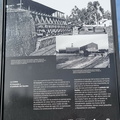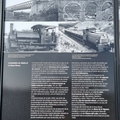Information Board outside the mining museum at El Granado (2) (via Google Translation)
(heading) ARRIVING AT THE PIER - the aerial cable
(top left photo) Aerial cable reception and unloading station and stationary machine, in Puerto La Laja.
(top right photo) A worker next to one of the poles through which the aerial cable that carried the mineral to the Port of La Laja passed.
(main text) The material that came out of the Cabezas del Pasto mine had to cross the steep orography until it reached the loading dock of the Port of La Laja. Once the railway line reached the Sardón, the British company The Bede Metal opted to build an aerial cable that, with a length of 4.3 kilometers, would carry the extracted mineral to the dock. It was the cheapest and fastest option to execute, although the transport capacity was limited. The project and construction, which was awarded to Guillermo Rödiger Zimmermann due to his extensive experience in the development of railways in the province of Huelva, was carried out in Germany. A system was installed with a tricable that was supported by 65 supports at a height of between 3 and 19.77 m. The layout was divided into two sections, installing a mixed station in the Casa del Contrapeso, in order to maintain the tension of the cables, due to the long distance that had to be covered. In the Sardón there was a charging station, next to the pier with the regulation deposits. located in a wagon siding.
For the transport of the merchandise, 110 vats, or calderillos, of 250 kilos were used that, in 10 hours of work, transported 150 tons. In addition, there were two more, closed, for transporting water that, on some occasion, the employees used to go more quickly from Sardón to La Laja. For unloading at the dock. The pier was modified, building a wooden station, with six masonry regulation tanks, to which two three-ton cranes with vertical boilers were added.
- Created on
- Thursday 29 December 2022
- Posted on
- Sunday 1 January 2023
- Albums
- Visits
- 6100
- Rating score
- no rating
- Rate this photo

